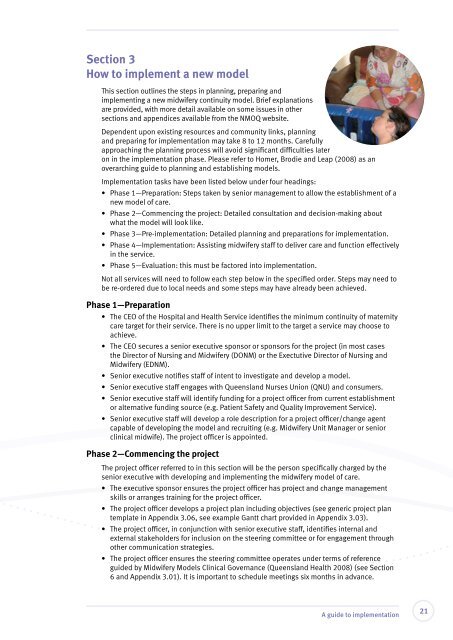Delivering continuity of midwifery care to Queensland women
Delivering continuity of midwifery care to Queensland women
Delivering continuity of midwifery care to Queensland women
Create successful ePaper yourself
Turn your PDF publications into a flip-book with our unique Google optimized e-Paper software.
Section 3<br />
How <strong>to</strong> implement a new model<br />
This section outlines the steps in planning, preparing and<br />
implementing a new <strong>midwifery</strong> <strong>continuity</strong> model. Brief explanations<br />
are provided, with more detail available on some issues in other<br />
sections and appendices available from the NMOQ website.<br />
Dependent upon existing resources and community links, planning<br />
and preparing for implementation may take 8 <strong>to</strong> 12 months. Carefully<br />
approaching the planning process will avoid significant difficulties later<br />
on in the implementation phase. Please refer <strong>to</strong> Homer, Brodie and Leap (2008) as an<br />
overarching guide <strong>to</strong> planning and establishing models.<br />
Implementation tasks have been listed below under four headings:<br />
• Phase 1—Preparation: Steps taken by senior management <strong>to</strong> allow the establishment <strong>of</strong> a<br />
new model <strong>of</strong> <strong>care</strong>.<br />
• Phase 2—Commencing the project: Detailed consultation and decision-making about<br />
what the model will look like.<br />
• Phase 3—Pre-implementation: Detailed planning and preparations for implementation.<br />
• Phase 4—Implementation: Assisting <strong>midwifery</strong> staff <strong>to</strong> deliver <strong>care</strong> and function effectively<br />
in the service.<br />
• Phase 5—Evaluation: this must be fac<strong>to</strong>red in<strong>to</strong> implementation.<br />
Not all services will need <strong>to</strong> follow each step below in the specified order. Steps may need <strong>to</strong><br />
be re-ordered due <strong>to</strong> local needs and some steps may have already been achieved.<br />
Phase 1—Preparation<br />
• The CEO <strong>of</strong> the Hospital and Health Service identifies the minimum <strong>continuity</strong> <strong>of</strong> maternity<br />
<strong>care</strong> target for their service. There is no upper limit <strong>to</strong> the target a service may choose <strong>to</strong><br />
achieve.<br />
• The CEO secures a senior executive sponsor or sponsors for the project (in most cases<br />
the Direc<strong>to</strong>r <strong>of</strong> Nursing and Midwifery (DONM) or the Exectutive Direc<strong>to</strong>r <strong>of</strong> Nursing and<br />
Midwifery (EDNM).<br />
• Senior executive notifies staff <strong>of</strong> intent <strong>to</strong> investigate and develop a model.<br />
• Senior executive staff engages with <strong>Queensland</strong> Nurses Union (QNU) and consumers.<br />
• Senior executive staff will identify funding for a project <strong>of</strong>ficer from current establishment<br />
or alternative funding source (e.g. Patient Safety and Quality Improvement Service).<br />
• Senior executive staff will develop a role description for a project <strong>of</strong>ficer/change agent<br />
capable <strong>of</strong> developing the model and recruiting (e.g. Midwifery Unit Manager or senior<br />
clinical midwife). The project <strong>of</strong>ficer is appointed.<br />
Phase 2—Commencing the project<br />
The project <strong>of</strong>ficer referred <strong>to</strong> in this section will be the person specifically charged by the<br />
senior executive with developing and implementing the <strong>midwifery</strong> model <strong>of</strong> <strong>care</strong>.<br />
• The executive sponsor ensures the project <strong>of</strong>ficer has project and change management<br />
skills or arranges training for the project <strong>of</strong>ficer.<br />
• The project <strong>of</strong>ficer develops a project plan including objectives (see generic project plan<br />
template in Appendix 3.06, see example Gantt chart provided in Appendix 3.03).<br />
• The project <strong>of</strong>ficer, in conjunction with senior executive staff, identifies internal and<br />
external stakeholders for inclusion on the steering committee or for engagement through<br />
other communication strategies.<br />
• The project <strong>of</strong>ficer ensures the steering committee operates under terms <strong>of</strong> reference<br />
guided by Midwifery Models Clinical Governance (<strong>Queensland</strong> Health 2008) (see Section<br />
6 and Appendix 3.01). It is important <strong>to</strong> schedule meetings six months in advance.<br />
A guide <strong>to</strong> implementation<br />
21
















